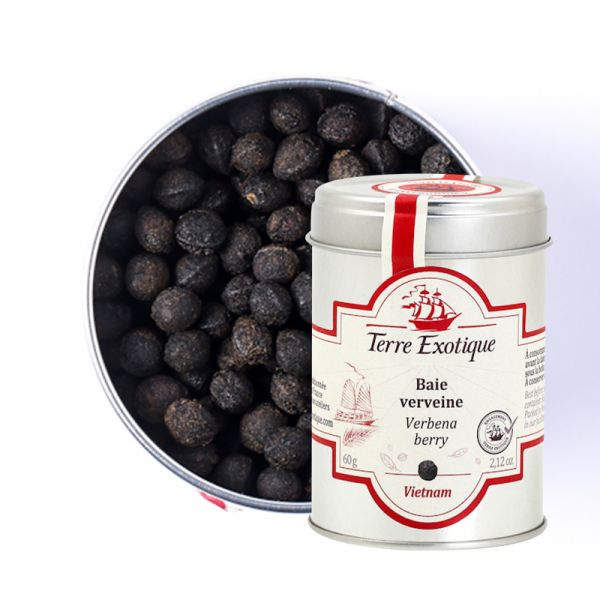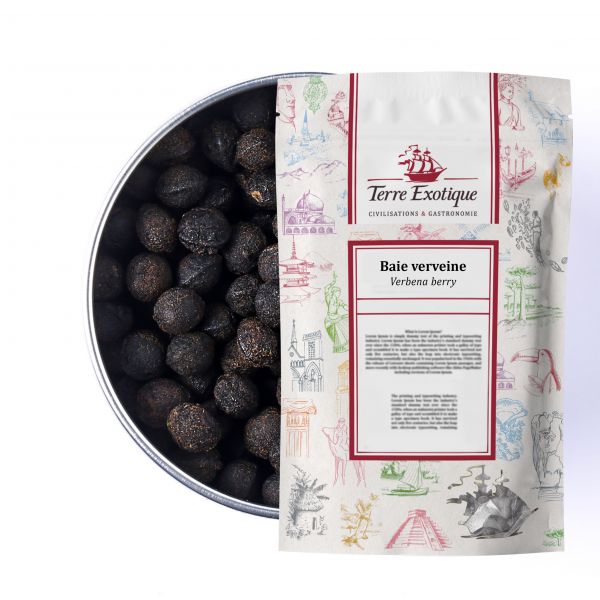



Usage of the verbena berry in cuisine
An exceptional-flavored berry, the verbena berry remains relatively unknown in Europe. However, this culinary gem is sure to captivate your taste buds!
Some suggestions for using the verbena berry in your dishes
The verbena berry can be used in numerous ways, both in savory and sweet recipes. Its citrus flavors enhance fish and crustaceans, bringing a touch of freshness and tanginess. The verbena berry can also be ground like pepper over white meats or crushed into a sauce or marinade.
The verbena berry pairs wonderfully with vegetables, whether they are sautéed, steamed, mashed, or in soups.
For Gin Tonic fans, you'll be pleased to know that the verbena berry can also be used as a substitute for juniper berries, ensuring a guaranteed success!
And that's not all! The verbena berry also finds its place in sweet cuisine. It integrates perfectly into fruity desserts, whether in fruit salads, coulis, compotes, tarts, or even jams. The citrus aromas of the verbena berry harmonize perfectly with chocolate and cream-based desserts.
Tips for using the verbena berry
To fully enjoy all its flavors, we recommend using the verbena berry:
- - Infused in a light syrup with lychee or strawberry soup;
- - Crushed over apricot or pear compote;
- - Ground on creamy scallops;
- - Coarsely crushed in a wok with chicken, beef, and stir-fried noodles.
Prefer to grind it using a mortar. Add it just before serving the dish to allow it to release all its flavors better.
The verbena berry, an explosion of flavors
Visually, this small berry resembles the round shape of the cubebe pepper.
Aromatically, the verbena berry reveals an intense fragrance: a mix of verbena, flowers, and exotic citrus.
Taste-wise, it presents a tangy warmth reminiscent of lemon candies. Its notes of verbena and citrus are delicate, floral, fruity, and even pungent. The verbena berry possesses exceptional and captivating aromas that are very refreshing.
The verbena berry and its botany
Verbena berry or Litsea cubeba
The botanical name of the verbena berry (Litsea cubeba) refers to the Cubeb pepper (Piper cubeba) due to their similar round shape. Litsea cubeba belongs to the Lauraceae family, just like the avocado tree, laurel, or cinnamon tree. The name of the verbena berry varies across languages and regions, but most names refer to its lemony scent: May chang, krangean, lado-lado, baleng la, medang ayer, medang melukut, chakhai-ton, takhrai, takhrai-ton.
How does the verbena berry grow?
The verbena berry comes from a shrub called Litsea cubeba, which grows in mountainous regions of China, Indonesia, and Vietnam. The Litsea cubeba can reach up to 12 meters in height and grows between 700 and 2300 meters above sea level. Its fruits are small, round, and shiny black. The Litsea cubeba ripens in June, with only one harvest per year, and the picking lasts for three months. The harvesting process is difficult and meticulous as the berries are carefully picked and sorted by hand. The verbena berries are harvested at their optimal ripeness when the grains start turning reddish on the branch. The drying process is natural, with the grains laid out in the sun for a week on bamboo mats.
History and culture of the verbena berry
Origins of the verbena berry
The verbena berry originates from Asia, specifically Vietnam and southern China. For centuries, Vietnamese people have primarily used it in traditional medicine, infusing it to combat sore throats and stimulate blood circulation. Its local name is "cây màng tang."
| Allergen | Absence |
|---|---|
| Native country | VIETNAM |
| Genus and botanical species | Litsea cubeba |
| Ingredients | Verbena berry |
| TRACES EVENTUELLES D'ALLERGÈNES | céleri, sésame, moutarde, fruits à coques. |
 Français
Français 


